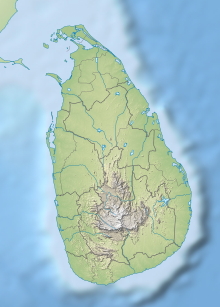Horton Plains National Park
| Horton Plains National Park | |
|---|---|
| හෝර්ටන් තැන්න ජාතික උද්යානය | |
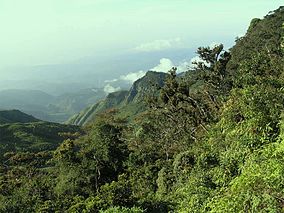 World's End,a sheer precipice within the park | |
| Location | Central province,Sri Lanka |
| Nearest city | OhiyaandNuwara Eliya |
| Coordinates | 6°48′N80°48′E/ 6.800°N 80.800°E |
| Area | 3,160 ha (12.2 sq mi) |
| Established | 1969 (Nature reserve) 1988 (National park) |
| Governing body | Department of Wildlife Conservation |
| World Heritage site | 2010 (within the siteCentral Highlands of Sri Lanka)[1] |
| UNESCO World Heritage Site | |
|---|---|
| Criteria | Natural: ix, x |
| Reference | 1203 |
| Inscription | 2010 (34thSession) |
| Area | 56,844 ha |
| Buffer zone | 72,645 ha |
Horton Plains National Park(Sinhala:හෝර්ටන් තැන්න ජාතික උද්යානය,romanized:Hortan Thanna Jathika Udyanaya) is anational parkin the central highlands ofSri Lankathat was designated in 1988. It is located at an elevation of 2,100–2,300 m (6,900–7,500 ft) and encompasses montanegrasslandandcloud forest.It is rich inbiodiversityand many species found here areendemicto the region. It is also a popular tourist destination and is situated 8 kilometres (5.0 mi) fromOhiya,6 kilometres (3.7 mi) from the world-famous Ohiya Gap/Dondra Watch and 32 kilometres (20 mi) fromNuwara Eliya.
The Horton Plains are theheadwatersof three major Sri Lankan rivers, theMahaweli,Kelani,andWalawe.InSinhalathe plains are known as Maha Eliya Plains (මහ එළිය තැන්න).Stone toolsdating back toBalangoda culturehave been found here. The plains' vegetation is grasslands interspersed with montane forest and includes many endemicwoody plants.Large herds ofSri Lankan sambar deerfeature as typical mammals and the park is also anImportant Bird Areawith many species not only endemic to Sri Lanka but restricted to the Horton Plains.Forest diebackis one of the major threats to the park and some studies suggest that it is caused by a natural phenomenon.
The sheer precipice ofWorld's EndandBaker's Fallsare among the tourist attractions of the park.
Physical features[edit]

Horton Plains is located on the southern plateau of the central highlands of Sri Lanka.[2]The peaks ofKirigalpoththa(2,389 m (7,838 ft)) andThotupola Kanda(2,357 m (7,733 ft)), the second and the third highest of Sri Lanka, are situated to the west and north respectively. The park'selevationranges from 1,200–2,300 m (3,900–7,500 ft).[3]The rocks in the park belong to theArcheanage and to the high series of thePrecambrianera and are made up ofKhondalites,Charnockitesand granitic gneisses.[4][5]Thesoil typeis of the red-yellowpodsolicgroup and the surface layer is covered with decayed organic matter.[4]
The mean annual rainfall is greater than 2,000 mm (79 in). Frequent cloud cover limits the amount of sunlight that is available to plants. The mean annual temperature is 13 °C (55 °F) but the temperature varies considerably during the course of a day, reaching as high as 27 °C (81 °F) during the daytime, and dipping as low as 5 °C (41 °F) at night. During the southwestmonsoonseason, the wind speed sometimes reachesgale force.Although some rain falls throughout the year, a dry season occurs from January–March. The groundfrostis common in February.Mistcan persist for most of the day during the wet season.[6]Many pools and waterfalls can be seen in the park, and Horton Plains is considered the most importantdrainage basinin Sri Lanka.[2]The Horton Plains are theheadwatersof important rivers such as theMahaweli,Kelani,andWalawe.[2]The plains also feeds Belihul Oya, Agra Oya, Kiriketi Oya, Uma Oya, and Bogawantalawa Oya.[6]
History[edit]
The original name of the area was Maha Eliya Thenna (මහ එළිය තැන්න - "great open plain" ). But in the British period the plains were renamed afterSir Robert Wilmot-Horton,theBritish governor of Ceylonfrom 1831 to 1837, who travelled to the area to meet the Ratemahatmaya of Sabaragamuwa in 1836,[4]in 1834 by Lt William Fisher of the78th Regimentand Lt. Albert Watson of the58th Regiment,who 'discovered' the plateau.[7]Stone toolsdating back toBalangoda culturehave been found here. The local population who resided in the lowlands ascended the mountains to mine gems, extractiron ore,construct an irrigational canal and fell trees for timber. A 6-metre (20 ft)pollen coreextracted from a mire revealed that in the latequaternaryperiod the area had a semi-arid climate and a species-restricted plant community.[8]
SinceSri Lankahas a long non-written history, there is a significant and logical folk story, which also goes with the epic 'Ramayana' with some deviations. It is believed thatThotupala mountainin Horton plain to be the place whereKing Rawanalanded his aircraft, 'Dandumonaraya'. According to the storyKing RawanakidnappedSitha,who was the wife of Rama as an act of revenge for cuttingKing Rawana's sister,Suparnika's nose. It provokedRamain India and he led an army that consisted of monkey-like humans, whose leader wasHanuman.In the story,Hanumanset fire to Horton plains and that fire lasted for a long time. The original name, Maha Eliya Thenna carries the meaning, 'The hugely lighten ground'. Even now the upper layer of soil can be seen in a blackish grey colour. There had been some soil tests done by local universities, and it revealed that the upper layer contains a high amount ofCalcium CarbonateandPotash.ForSri Lankans,Horton Plains is very significant in their History and Culture.[citation needed]
SirJoseph Dalton Hookerhad advised theBritish Government"to leave all Montane Forests above 5000 ft. undisturbed" and an administrative order to this effect had been issued in 1873 that prevented clearing and felling of forests in the region. Horton Plains was designated as awildlife sanctuaryon 5 December 1969,[4]and because of its biodiversity value, was elevated to anational parkon 18 March 1988. ThePeak Wilderness Sanctuarywhich lies in the west is contiguous with the park. The land area covered by Horton Plains is 3,160 hectares (12.2 sq mi). Horton Plains contains the most extensive area of cloud forest still existing in Sri Lanka.[4]In July 2010, theCentral Highlands of Sri Lankawhich incorporates Horton Plains National Park,Peak Wilderness SanctuaryandKnuckles Mountain Rangewas inscribed on theWorld Heritage List.[1]
Flora[edit]
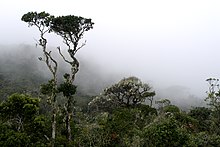
The vegetation of the park is classified into two distinctive groups, 2,000 ha (7.7 sq mi) of wet patna (Sinhalese:patana,montane grasslands and shrublands) and 1,160 ha (4.5 sq mi) ofsubtropicalmontaneevergreen forests.[2]Nearly 750 species of plants belonging to 20 families have been recorded in the park. The forestcanopyreaches the height of 20 m (66 ft) and featuresCalophyllum walkeri,forming communities with varieties ofMyrtaceaespecies such asSyzygium rotundifolium,andS. sclerophyllum,andLauraceaemembers includingLitsea,Cinnamomum,andActinodaphne speciosa.[4]Theundergrowthlayer is characterised byStrobilanthesspp. The thickness of theStrobilanthesvegetation hinders the development of a herb layer. Dwarf bamboo species suchIndocalamusandOchlandraare also found in the undergrowth layer.Rhodomyrtus tomentosabushes especially grow inforest marginand near the mountain peaks. Species such asGordoniaandRhododendron arboreumhave spread to Sri Lanka, along theWestern GhatsofSouth Indiafrom theHimalayasand are now common. Nearly 54woody plantspecies have been recorded from the park, of which 27 (50%) are endemic to Sri Lanka.[4] Frequent fire andgrazingcharacterisesPlagioclimax communitiesof the grassland flora.[2]Grasslands are dominated byArundinella villosaandChrysopogon zeylanicus.Waterloggedswampsor slow-moving streams are found in low-lying areas, andmacrophytessuch asAponogetonjacobsenii,sedgespeciesIsolopis fluitansandUtriculariaspp. are found near the slow-moving streams. ThebambooChimonobambusa densifoliathrive along the banks of the streams, and near the swampy areas grass species such asJuncus prismatocarpus,Garnotia mutica,Eriocaulonspp. andExacumtrinerviumare common.Tussock grassessuch asChrysopogonzeylanicusandCymbopogonconfertiflorusare found in the wet hollows.[4]Herbaceous floraof the grasslands include temperate species includingRanunculus,Pedicularis,Senecio,GentianaandAlchemillaand also tropical species such asEriocaulonandIpsea speciosa(a rare endemic daffodil orchid). The most widespreadborealherbaceous plants of the park areViola,Lobelia,Gaultheria,Fragaria,andPlantago.[9]
Tree trunks and branches are ornamented with many species offerns,Lycopodium,lichens,andorchids.[6]Old man's beard (Usneabarbata) hanging from branches adds to the beauty of the forests. About 16 of the orchid species are endemic. Other notable plants include shrubs such asRhodomyrtus tomentosa,Gaultheria fragrantissima,herbs,Exacum trinervium,E. walkeri,Drosera indica,andtree fernsCyatheaspp.[2]Anzia,a foliose lichen genus belonging to the familyParmeliaceae,which had not been recorded in Sri Lanka before, was discovered here in 2007.[3]There are conflicting views on how the grasslands of the park came into being, whether man-made or natural. It is now believed that the grasslands on the dry slopes were created by forest clearance and fires while grasslands in low-lying areas were naturally created by wet conditions,frostand soilerosion.[4]
Fauna[edit]
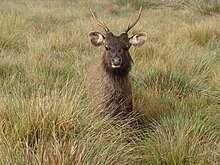
The vertebrate fauna of the region includes 24 species of mammals, 87 species of birds, nine species of reptiles and eight species of amphibians.[2]TheSri Lankan elephantdisappeared from the region in the 1940s at the latest.[4]At present, the largest and the most commonly seen mammal is thesambar deer.Some research findings estimate the population of sambar deer to be around 1500 to 2000, possibly more than the carrying capacity of the plains.[6]Other mammal species found in the park includeKelaart's long-clawed shrews,toque macaques,purple-faced langurs,rusty-spotted cat,Sri Lankan leopards,wild boars,stripe-necked mongooses,Sri Lankan spotted chevrotains,Indian muntjacs,andgrizzled giant squirrels.Fishing catsandEuropean ottersvisit the wetlands of the park to prey on aquatic animals.[2]A subspecies ofred slender loris,the Horton Plains slender loris (Loris tardigradus nycticeboidesformerly sometimes considered asLoris lydekkerianus nycticeboides) is found only in highlands of Sri Lanka and is considered one of the world's most endangered primates.[10][11]In July 2010 a group of researchers from theZoological Society of Londonwas able to photograph the mammal for the first time.[12]
In 2016,rusty-spotted cats(Prionailurus rubiginosus) were recorded in Horton Plains National Park for the first time, at altitudes of 2,084–2,162 m (6,837–7,093 ft).[13]
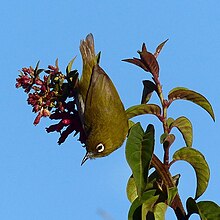
Along withOhiya,Pattipola andAmbewela,Horton Plains forms one of theImportant Bird Areas(IBAs) in Sri Lanka.[14]Together with the adjacentPeak Wilderness Sanctuary,Horton Plains contains 21 bird species which occur only on Sri Lanka. Three, thedull-blue flycatcher,Sri Lanka white-eye,andSri Lanka wood pigeon,occur only in Horton plains, while other endemic species includeSri Lanka blue magpie,Sri Lanka spurfowl,Sri Lanka junglefowl,yellow-fronted barbet,orange-billed babbler,Sri Lanka bush warbler,andSri Lanka whistling-thrush.Many birdsmigratehere in winter includingswiftlets,andalpine swift.Crested serpent eagle,mountain hawk-eagle,black-winged kite,andperegrine falconare among thebirds of preyfound in Horton Plains.Harriersare among the migratory raptors.[2]This is a key wildlife area. All six highland endemic birds are found here, including dull-blue flycatcher, Sri Lanka white-eye, Sri Lanka wood pigeon, and Sri Lanka bush warbler.Yellow-eared bulbulandblack-throated muniaare widespread throughout the highlands.[4]
Sri Lanka is considered a herpetological paradise in the world.[6]Possibly about 15 amphibian species inhabit the park. Among them areMicrohyla zeylanica,Uperodon palmatus,Zakerana greenii,Hydrophylax gracilis,Pseudophilautus alto,Pseudophilautus femoralis,Pseudophilautus frankenbergi,Pseudophilautus microtympanum,Pseudophilautus schmarda,andTaruga eques.De Silva has observed five endemic reptiles from the plains. They areCalotes nigrilabris,Rhino-horned lizard,Cophotis ceylanica,Lankascincus taprobanensisandcommon rough-sided snake.Two fish species found in the park,common carpandrainbow trout;both areintroduced species.[2]Horton Plains is also home to many endemiccrustaceansincludingCaridina singhalensisandPerbrinckiaspecies. The endemic freshwater shrimpCaridina singhalensisis found only in streams that have a temperature of less than 15 degrees C and is now restricted to only a stretch of 10 km of one stream.[15]
Threats and conservation management[edit]

Horton Plains was a part of a large system of plains and forest cover that included Agra-Bopats, Moon Plains and Elk Plains.[4]Between 1831 and 1948, it became a Sambar deer hunting ground. Elephants and Wild boars were also hunted to a lesser extent. During this period lower slopes were cleared initially for coffee and then fortea plantations.As a result, Horton Plains and Peak Wilderness became isolated from other forest and grassland areas. Potatoes were cultivated in the grasslands but planting ceased in 1977. After being declared a National Park, these areas were reinstated as grasslands. Tourism-related issues such as plant removal, littering,firesand noise pollution are major conservation issues.[2]Gem mining,timber logging,the collection of plants for ornamental andmedicinalpurposes, encroachment,poachingand vehicle traffic are the other threats. The spread ofinvasivealien species such as gorse (Ulex europaeus), Mist Flower (Ageratina riparia), Crofton Weed (Ageratina adenophora), (Austroeupatorium), Blue Stars (Aristea ecklonii),brackens,andPennisetumspp. threaten the native flora.[16][17][18]The introduced rainbow trout may have affected endemic species of fish, amphibia and crustaceans.[4]
Owing to the relatively small size of Horton Plains National Park, it was predicted that most male leopards have activity centres that were outside the park.[19]Hence, continued protection of the national park and integrated management of landscapes outside of the national park is essential for the conservation of the species there.
Some sambar deer have died due to eating polythene litter that blocked their food passages, and visitors are banned from bringing polythene into the park.[20]Sambar have benefited from the introducedPennisetumgrass species.[21]
A recent threat, first reported in 1978, isforest dieback.[4]In some areas, especially in the peripheral region, this has been severe with nearly a 50% in vegetation. Water deficiency has been attributed as the main cause of dieback asdroughtsare becoming more frequent. The regrowth of forest is hindered by frost which is increasingly severe. The forest dieback has affected 22 species of plants withCalophyllum walkeribeing the most affected.[22]A study has suggested that low calcium causessoil acidificationand increased toxicity caused by metallic elements such as aluminium may be causing the dieback.Leachingof nutrients and the resulting imbalance in soilmicronutrientsmay also be contributing to the dieback.[23]
Tourist attractions[edit]

Horton Plains is a popular tourist destination, withWorld's Endbeing the key attraction.[2]In the six months ending in August 2009, Horton Plains National Park earned a revenue of Rs. 20.1 million (US$0.17 million).[24]The park is accessed by the Nuwara Eliya-Ambewela-Pattipola andHaputale-Boralandaroads, and there are railway stations atOhiyaandAmbewela.
World's End is a sheerprecipicewith a 870 m (2,854 ft) drop.[6]It is situated at the southern boundary of the park. Another cliff known as the Lesser World's End of 270 m (886 ft) is located not far from World's End.
Baker's Falls,a waterfall formed by Belihul Oya, a tributary of the Walawe River is named after SirSamuel Baker,a hunter and explorer[25]who attempted to establish a European agricultural settlement atNuwara Eliya.The waterfall is 20 metres (66 ft) high. Slab Rock Falls is another well-known waterfall in the plains. The waterfall can be reached by walking on one of the main trails; the trail is a bit steep at the end but the difficulty level is medium to easy.[6]
See also[edit]
References[edit]
- ^ab"World Heritage Committee inscribes two new sites on World Heritage List".unesco.org.UNESCO.July 30, 2010.Retrieved1 August2010.
- ^abcdefghijkl"Horton Plains National Park".International Water Management Institute.Archived fromthe originalon August 5, 2010.Retrieved23 November2009.
- ^abJayalal, R.G.U.; Wolseley, P.; Pathberiya, L.G.; Wijesundara, D.S.A.; Karunaratne, V. (2007)."Anzia(Lichenized Ascomycetes, Parmeliaceae) A New Record from the Horton Plains National Park, Sri Lanka "(PDF).Proceedings of the Peradeniya University Research Sessions, Sri Lanka.Archived fromthe original(PDF)on 17 June 2011.
- ^abcdefghijklmnGreen, Michael J. B. (1990). "Horton Plains National Park".IUCN directory of South Asian protected areas.IUCN.pp.216–219.ISBN2-8317-0030-2.
- ^Ranasinghe, P.; Fernando, G.; Dissanayake, C.; Rupasinghe, M. (2008). "Stream sediment geochemistry of the Upper Mahaweli River Basin of Sri Lanka—Geological and environmental significance".Journal of Geochemical Exploration.99(1–3): 1–28.doi:10.1016/j.gexplo.2008.02.001.
- ^abcdefgde Silva, A. (2007).The Diversity of Horton Plains National Park (with special reference to its herpetofauna).Vijitha Yapa Publishers. pp. 273+xiv.ISBN978-955-1266-61-5.Archived fromthe originalon 2011-07-17.
- ^Vinod Moonesinghe, "OMG! And the Fishers of Ramboda",Ceylon Daily News,22 June 2012.Archived19 October 2012 at theWayback Machine
- ^Premathilake, Rathnasiri; Risberg, Jan (2003)."Late Quaternary climate history of the Horton Plains, central Sri Lanka".Quaternary Science Reviews.22(14): 1525–1541.Bibcode:2003QSRv...22.1525P.doi:10.1016/S0277-3791(03)00128-8.
- ^Campbell, D. H.(1926)."Ceylon".An outline of plant geography.New York:Macmillan Publishers.p. 191.
- ^Nekaris, K. A. I. (2007)."Horton Plains Slender Loris, Ceylon Mountain Slender Loris,Loris tardigradus nycticeboidesHill, 1942. In: Primates in Peril: The World's 25 Most Endangered Primates 2006–2008 ".primate-sg.org.Arlington, VA: Unpublished report, IUCN/SSC Primate Specialist Group (PSG), International Primatological Society (IPS), andConservation International(CI). pp. 12–13. Archived fromthe originalon 2009-03-28.
- ^Perera, M.; Sandun J. (2008)."A Review of the Distribution of Grey Slender Loris (Loris lydekkerianus) in Sri Lanka "(PDF).Primate Conservation.23:89–96.doi:10.1896/052.023.0110.S2CID8941145.Archived fromthe original(PDF)on 2009-02-05.
- ^Hough, A. (19 July 2010)."Horton Plains Slender Loris pictured for first time".The Daily Telegraph.Archived fromthe originalon 21 July 2010.Retrieved5 August2010.
- ^Nimalrathna, T.; Choo, Y. R.; Kudavidanage, E.; Amarasinghe, T.; Bandara, U.; Wanninayaka, W.; Ravindrakumar, P.; Chua, M.A.H.; Webb, E.L. (2019)."First photographic record of the Rusty-spotted CatPrionailurus rubiginosus(I. Geoffroy Saint-Hilaire, 1831) (Mammalia: Carnivora: Felidae) in Horton Plains National Park, Sri Lanka ".Journal of Threatened Taxa.11(4): 13506–13510.doi:10.11609/jott.4094.11.4.13506-13510.
- ^"IBAs in Sri Lanka".birdlife.org.BirdLife International.Retrieved6 December2009.
- ^de Silva, K.H.G.M. (1982). "Aspects of the ecology and conservation of Sri Lanka's endemic freshwater shrimpCaridina singhalensis".Biological Conservation.24(3): 219–231.doi:10.1016/0006-3207(82)90059-3.
- ^Lalith Gunasekera,“Alien plants invasion in Horton Plains”,Sri Lanka Guardian,23.9.2011. Accessed 19.6.2016.
- ^Milan Lu, ““A growing threat”Archived2016-08-13 at theWayback Machine,Ceylon Today,01.11.2011. Accessed 19.6.2016.
- ^Ranwala, S.; Marambe, B.; Wijesundara, S.; Silva, P.; Weerakoon, D.; Atapattu, N.; Gunawardena, J.; Manawadu, L. & Gamage, G. (2012)."Post-entry risk assessment of invasive alien flora in Sri Lanka-present status, GAP analysis, and the most troublesome alien invaders".Pakistan Journal of Weed Science Research(Special Issue): 863–871.
- ^Webb, Edward L.; Choo, Yan Ru; Kudavidanage, Enoka P.; Amarasinghe, Thakshila Ravindra; Sumith Indika Bandara, Udamulle Gedara; Charitha Lakmali Wanninayaka, Wanninayaka Aarahchilage; Ravindrakumar, Piyal; Nimalrathna, Thilina Sudarshana; Liang, Song Horng; Chua, Marcus Aik Hwee (September 2020)."Leopard activity patterns in a small montane protected area highlight the need for integrated, collaborative landscape conservation".Global Ecology and Conservation.23:e01182.doi:10.1016/j.gecco.2020.e01182.
- ^Fernando, V. (2002)."Horton Plains: Nature's pristine glory".Sunday Observer.Archivedfrom the original on 4 January 2010.Retrieved24 November2009.
- ^Padmalal, U.K.G.K.; Takatsuki, S.; Jayasekara, P. (2003). "Food habits of sambarCervus unicolorat the Horton Plains National Park, Sri Lanka ".Ecological Research.18(6): 775.doi:10.1111/j.1440-1703.2003.00595.x.S2CID22901926.
- ^Werner, W. L. (1988). "Canopy dieback in the upper montane rain forests of Sri Lanka".GeoJournal.17(2): 245–248.doi:10.1007/BF02432929.S2CID189885528.
- ^Chandrajith, R.; Koralegedara, N.; Ranawana, K. B.; Tobschall, H. J.; Dissanayake, C. B. (2008). "Major and trace elements in plants and soils in Horton Plains National Park, Sri Lanka: an approach to explain forest die back".Environmental Geology.57:17–28.doi:10.1007/s00254-008-1278-0.S2CID130388413.
- ^Sriyananda, Shanika (August 8, 2009)."Wildlife picks up with end of war".Sunday Observer.Archivedfrom the original on 5 September 2009.Retrieved24 November2009.
- ^Baker, SW (1854).The rifle and the hound in Ceylon.Longman, Brown, Green and Longmans, London.
External links[edit]
![]() Media related toHorton Plains National Parkat Wikimedia Commons
Media related toHorton Plains National Parkat Wikimedia Commons

